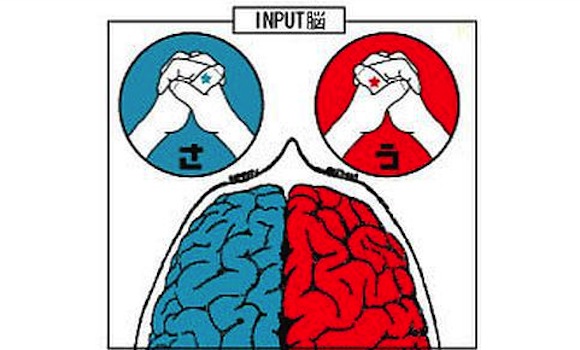
Everybody, go ahead and cross your arms right now. Done? Alright. Now, try to cross them the other way. If you’re currently crossed with right forearm on top, try to switch position so that your left forearm is on top. Feels incredibly awkward and unnatural, doesn’t it?
It turns out most people have a natural bias for arm-crossing direction, with slightly more than half of most global populations preferring the left-forearm-on-top approach, although the two preferences are basically 50-50. Some people apparently cross their arms either way without even thinking about it, although this population is exceedingly small.
So why do we humans find one way so natural and the other way so incredibly weird-feeling? It may have something to do with your psychological composition, according to the (admittedly somewhat unreliable) Japanese Internet.
This graph breaks it down:
Here we see a cross-section of personality type and arm-crossing and finger-weaving preference. To figure out your finger-weaving preference, interlock your fingers like you’re Oliver Twist begging for more porridge and pay attention to which thumb is on top; You’ll obviously be either right-thumbed or left-thumbed.
Let’s take a look at a breakdown of what each category means:
If you both cross your arms and weave your hands right-over-left, you apparently are inclined to think critically before arriving at a first impression, and think critically when confronting problems or drawing deeper conclusions.
Those that cross their arms right-over-left, but weave hands left-over-right tend to go with their gut when it comes to first impressions, but give more logical thought to things when drawing deeper conclusions or confronting a problem that needs solved.
Left-over-right arm-crossing hand-weavers are supposedly the most brash of the bunch, leaving everything up to gut instinct.
Finally, if you tend to cross your arms left-over-right but weave your hands right-over-left, then your first impressions tend to be well-thought out, while you leave more complex issues to instinct.
For further proof, here’s a diagram about left-brain and right-brain or something:
Here’s the part where I’m supposed to tell you that I tried this myself and found that my arm-crossing and hand-weaving preferences and problem-solving style matched closely with the conclusions drawn by these diagrams, but that’s actually not what happened.
In fact, it appears arm-crossing and hand-weaving preferences are largely random, probably chosen by each individual as a child when first learning to perform these actions and reinforced over many years until going the opposite direction starts to feel very unnatural. Family studies have borne this out, with right-over-left-preferring parents giving birth to left-over-right-preferring kids about 50% of the time, and vice versa. Even more damning to the theory put forward by the above diagrams, twins have opposite arm and hand-folding preferences about as often as they have the same preferences, strongly indicating that genetics don’t influence an individual’s preference and, subsequently, that it’s probably not a strong indicator of psychological tendencies.
Apparently, some people also believe that this Geocities-era Internet spam .gif is an accurate predictor of left or right-brained-ness:
Never mind that the dancer frequently switches spinning direction the more you look at it.
But hey, it’s fun to think about it, right? And it’s at least (probably, ever so slightly) more scientifically sound than trying to read the future in animal bones.
Source and photos: Kininaru Sokuhou




 Harrowing video sees reckless drivers ignore pedestrian crossing in Japan【Video】
Harrowing video sees reckless drivers ignore pedestrian crossing in Japan【Video】 Theory that men cannot beat women at Japanese karuta card game has Internet nodding in agreement
Theory that men cannot beat women at Japanese karuta card game has Internet nodding in agreement Blink and you’ll miss what riled racists in this Japanese McDonald’s ad 【Video】
Blink and you’ll miss what riled racists in this Japanese McDonald’s ad 【Video】 We take a giraffe nap in a standing sleep pod at a cafe in Tokyo
We take a giraffe nap in a standing sleep pod at a cafe in Tokyo Are you a control freak, baby, or tough guy? Find out what your sleeping position says about you!
Are you a control freak, baby, or tough guy? Find out what your sleeping position says about you! How to order snacks on a Shinkansen bullet train in Japan
How to order snacks on a Shinkansen bullet train in Japan Japan’s new difficult-to-drink-from beer glass protects your liver, but it’s a brutal experience
Japan’s new difficult-to-drink-from beer glass protects your liver, but it’s a brutal experience Burger King Japan suddenly adds Dr. Pepper and Dr. Pepper floats to its menu nationwide
Burger King Japan suddenly adds Dr. Pepper and Dr. Pepper floats to its menu nationwide Demon Slayer: Kimetsu no Yaiba gets new roller coaster attractions and food at Universal Studios Japan
Demon Slayer: Kimetsu no Yaiba gets new roller coaster attractions and food at Universal Studios Japan Hello, cosmetics! Clinique teams up with Hello Kitty this summer for first-time collaboration
Hello, cosmetics! Clinique teams up with Hello Kitty this summer for first-time collaboration Kyoto Tower mascot termination reveals dark side behind cute Japanese characters
Kyoto Tower mascot termination reveals dark side behind cute Japanese characters Nintendo history you can feel – Super NES, N64, and GameCube controllers become capsule toys
Nintendo history you can feel – Super NES, N64, and GameCube controllers become capsule toys This Nara workshop has been making deer crackers for more than 100 years and offers tours【Photos】
This Nara workshop has been making deer crackers for more than 100 years and offers tours【Photos】 High-fashion Totoro cuddle purse is like an elegant stroll in the forest【Photos】
High-fashion Totoro cuddle purse is like an elegant stroll in the forest【Photos】 Legendary Melon Bread by Tokyo Banana returns after 20-year absence【Taste Test】
Legendary Melon Bread by Tokyo Banana returns after 20-year absence【Taste Test】 “The most Delicious Cup Noodle in history” – Japan’s French Cup Noodle wins our heart【Taste test】
“The most Delicious Cup Noodle in history” – Japan’s French Cup Noodle wins our heart【Taste test】 Starbucks releases a cute Frappuccino and Unicorn Cake…but not in Japan
Starbucks releases a cute Frappuccino and Unicorn Cake…but not in Japan McDonald’s Japan’s Soft Twist Tower: A phantom ice cream only sold at select branches
McDonald’s Japan’s Soft Twist Tower: A phantom ice cream only sold at select branches Yabai Ramen: What makes this Japanese ramen so dangerous?
Yabai Ramen: What makes this Japanese ramen so dangerous? Finally! Nintendo Japan expands Switch 8-bit controller sales to everybody, Online member or not
Finally! Nintendo Japan expands Switch 8-bit controller sales to everybody, Online member or not Japanese government wants to build luxury resorts in all national parks for foreign tourists
Japanese government wants to build luxury resorts in all national parks for foreign tourists To combat declining birth rate, Japan to begin offering “Breeding Visas” to foreigners
To combat declining birth rate, Japan to begin offering “Breeding Visas” to foreigners 10 things you should buy at 7-Eleven in Japan
10 things you should buy at 7-Eleven in Japan Studio Ghibli releases anime heroine cosplay dresses that are super comfy to wear
Studio Ghibli releases anime heroine cosplay dresses that are super comfy to wear Woman charged for driving suitcase without a license in Osaka
Woman charged for driving suitcase without a license in Osaka Studio Ghibli unveils My Neighbour Totoro miniature house model
Studio Ghibli unveils My Neighbour Totoro miniature house model Kyoto experiencing problems with foreign tourists not paying for bus fares, but not on purpose
Kyoto experiencing problems with foreign tourists not paying for bus fares, but not on purpose Fighting mild hunger with a Japanese soda that turns into jelly in the stomach【Taste test】
Fighting mild hunger with a Japanese soda that turns into jelly in the stomach【Taste test】 Studio Ghibli’s Howl’s Moving Castle tapestry unveiled in Japan for first time
Studio Ghibli’s Howl’s Moving Castle tapestry unveiled in Japan for first time McDonald’s new Happy Meals offer up cute and practical Sanrio lifestyle goods
McDonald’s new Happy Meals offer up cute and practical Sanrio lifestyle goods Sales of Japan’s most convenient train ticket/shopping payment cards suspended indefinitely
Sales of Japan’s most convenient train ticket/shopping payment cards suspended indefinitely Sold-out Studio Ghibli desktop humidifiers are back so Totoro can help you through the dry season
Sold-out Studio Ghibli desktop humidifiers are back so Totoro can help you through the dry season Japanese government to make first change to romanization spelling rules since the 1950s
Japanese government to make first change to romanization spelling rules since the 1950s Foreigner’s request for help in Tokyo makes us sad for the state of society
Foreigner’s request for help in Tokyo makes us sad for the state of society Ghibli founders Toshio Suzuki and Hayao Miyazaki contribute to Japanese whisky Totoro label design
Ghibli founders Toshio Suzuki and Hayao Miyazaki contribute to Japanese whisky Totoro label design Doraemon found buried at sea as scene from 1993 anime becomes real life【Photos】
Doraemon found buried at sea as scene from 1993 anime becomes real life【Photos】 Tokyo’s most famous Starbucks is closed
Tokyo’s most famous Starbucks is closed Princesses, fruits, and blacksmiths: Study reveals the 30 most unusual family names in Japan
Princesses, fruits, and blacksmiths: Study reveals the 30 most unusual family names in Japan Himakajima: The Japanese island with one traffic light that only turns green once a year
Himakajima: The Japanese island with one traffic light that only turns green once a year Coronavirus outbreak delays Nintendo Switch Animal Crossing console production, orders
Coronavirus outbreak delays Nintendo Switch Animal Crossing console production, orders Believe in the nap of the cards with the crazy Yu-Gi-Oh! Duel Disk Nap Pillow【Photos】
Believe in the nap of the cards with the crazy Yu-Gi-Oh! Duel Disk Nap Pillow【Photos】 What sorcery is this?! New toy aquarium is populated with your own hand-drawn fish 【Video】
What sorcery is this?! New toy aquarium is populated with your own hand-drawn fish 【Video】 Allergic to cats, but still love them? This is the perfect T-shirt for you
Allergic to cats, but still love them? This is the perfect T-shirt for you Personality test-obsessed Japan devises “Frozen” princess personality test for women
Personality test-obsessed Japan devises “Frozen” princess personality test for women Japanese theme park now offering fake thugs you can “beat up” to impress your girlfriend【Video】
Japanese theme park now offering fake thugs you can “beat up” to impress your girlfriend【Video】 Check out the ball-handling skills of classical Japanese aristocrats with this new video
Check out the ball-handling skills of classical Japanese aristocrats with this new video Japanese cosmetics ad has women recoiling in horror as ugly man tries to help one of them【Video】
Japanese cosmetics ad has women recoiling in horror as ugly man tries to help one of them【Video】 Our Japanese staff take on the Invisible Box Challenge that’s going viral【Video】
Our Japanese staff take on the Invisible Box Challenge that’s going viral【Video】 Tokyo University students rank the top 12 video games for cultivating smart kids
Tokyo University students rank the top 12 video games for cultivating smart kids New Pikachu PC cushion is here to recharge your work-from-home work ethic【Photos】
New Pikachu PC cushion is here to recharge your work-from-home work ethic【Photos】 Live your life hands-free and let these huge hands from Village Vanguard hold everything for you
Live your life hands-free and let these huge hands from Village Vanguard hold everything for you Car accident reminds us of the obvious dangers of driving while eating instant ramen
Car accident reminds us of the obvious dangers of driving while eating instant ramen De-stress and breathe easy with handy tip from Japanese vocal technique specialist
De-stress and breathe easy with handy tip from Japanese vocal technique specialist
Leave a Reply